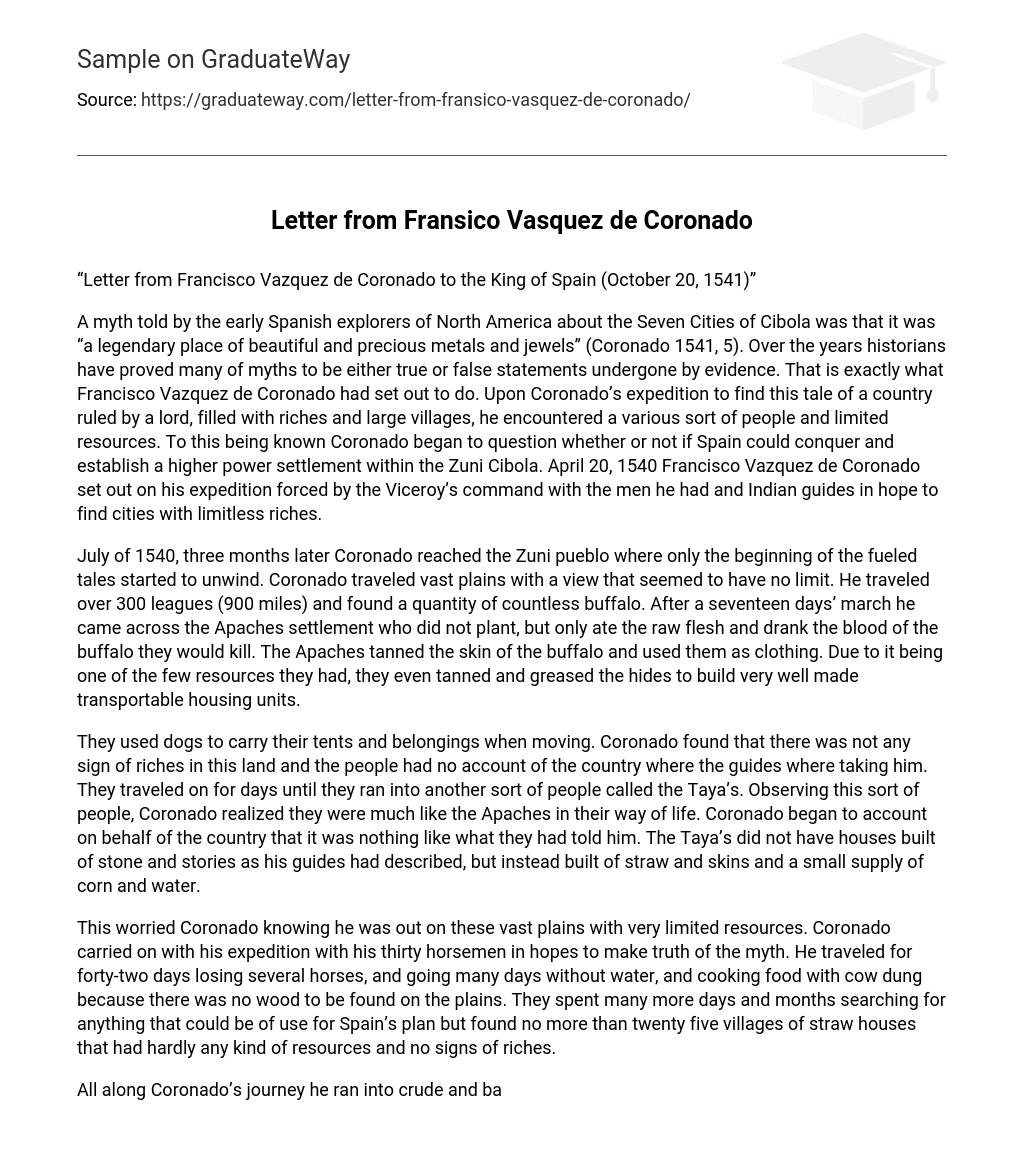“Letter from Francisco Vazquez de Coronado to the King of Spain (October 20, 1541)”
A myth told by the early Spanish explorers of North America about the Seven Cities of Cibola was that it was “a legendary place of beautiful and precious metals and jewels” (Coronado 1541, 5). Over the years historians have proved many of myths to be either true or false statements undergone by evidence. That is exactly what Francisco Vazquez de Coronado had set out to do. Upon Coronado’s expedition to find this tale of a country ruled by a lord, filled with riches and large villages, he encountered a various sort of people and limited resources. To this being known Coronado began to question whether or not if Spain could conquer and establish a higher power settlement within the Zuni Cibola. April 20, 1540 Francisco Vazquez de Coronado set out on his expedition forced by the Viceroy’s command with the men he had and Indian guides in hope to find cities with limitless riches.
July of 1540, three months later Coronado reached the Zuni pueblo where only the beginning of the fueled tales started to unwind. Coronado traveled vast plains with a view that seemed to have no limit. He traveled over 300 leagues (900 miles) and found a quantity of countless buffalo. After a seventeen days’ march he came across the Apaches settlement who did not plant, but only ate the raw flesh and drank the blood of the buffalo they would kill. The Apaches tanned the skin of the buffalo and used them as clothing. Due to it being one of the few resources they had, they even tanned and greased the hides to build very well made transportable housing units.
They used dogs to carry their tents and belongings when moving. Coronado found that there was not any sign of riches in this land and the people had no account of the country where the guides where taking him. They traveled on for days until they ran into another sort of people called the Taya’s. Observing this sort of people, Coronado realized they were much like the Apaches in their way of life. Coronado began to account on behalf of the country that it was nothing like what they had told him. The Taya’s did not have houses built of stone and stories as his guides had described, but instead built of straw and skins and a small supply of corn and water.
This worried Coronado knowing he was out on these vast plains with very limited resources. Coronado carried on with his expedition with his thirty horsemen in hopes to make truth of the myth. He traveled for forty-two days losing several horses, and going many days without water, and cooking food with cow dung because there was no wood to be found on the plains. They spent many more days and months searching for anything that could be of use for Spain’s plan but found no more than twenty five villages of straw houses that had hardly any kind of resources and no signs of riches.
All along Coronado’s journey he ran into crude and barbarous people, people who hoped they would die of hunger. These people barely owned anything, and lived out in the middle of widespread plains with no communication and nothing but bull and buffalo. Although he found land that could sustain Spain’s crops in Tiguex he did not find any riches that would be of value to the Spanish King. Francisco Vasquez de Coronado had found nothing remotely close to what the Friar had told, to this Coronado wrote to the King “It would not be possible to establish a settlement here”. (Coronado 1541, 7)
WORK CITED
Coronado, Francisco Vazquez de. “Letter from Francisco Vazquez de Coronado to the King of Spain.” (1541): 5-7.





